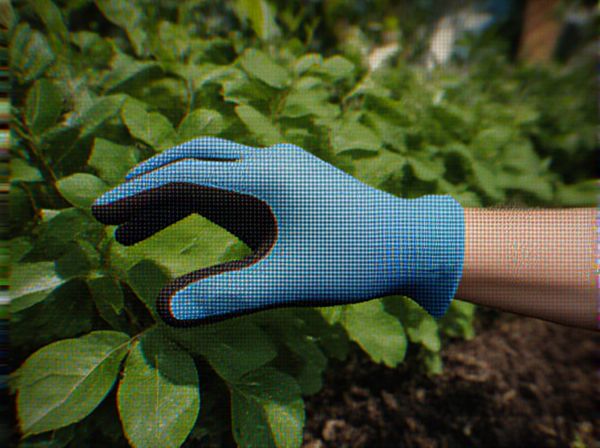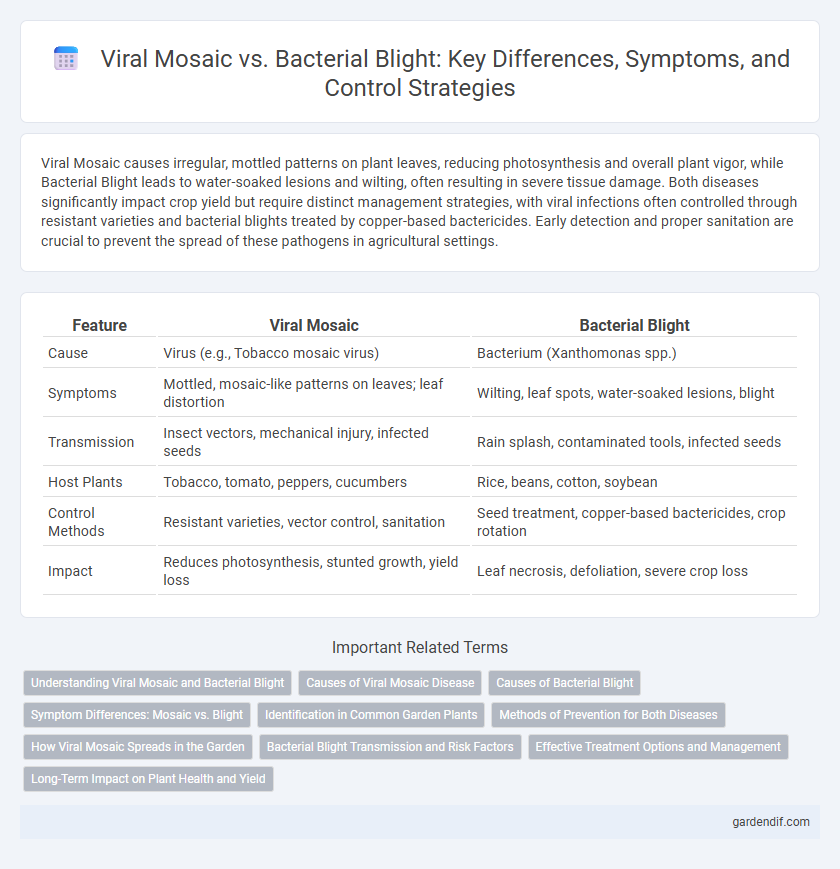
Viral Mosaic vs Bacterial Blight Illustration
Viral Mosaic causes irregular, mottled patterns on plant leaves, reducing photosynthesis and overall plant vigor, while Bacterial Blight leads to water-soaked lesions and wilting, often resulting in severe tissue damage. Both diseases significantly impact crop yield but require distinct management strategies, with viral infections often controlled through resistant varieties and bacterial blights treated by copper-based bactericides. Early detection and proper sanitation are crucial to prevent the spread of these pathogens in agricultural settings.
Table of Comparison
| Feature | Viral Mosaic | Bacterial Blight |
|---|---|---|
| Cause | Virus (e.g., Tobacco mosaic virus) | Bacterium (Xanthomonas spp.) |
| Symptoms | Mottled, mosaic-like patterns on leaves; leaf distortion | Wilting, leaf spots, water-soaked lesions, blight |
| Transmission | Insect vectors, mechanical injury, infected seeds | Rain splash, contaminated tools, infected seeds |
| Host Plants | Tobacco, tomato, peppers, cucumbers | Rice, beans, cotton, soybean |
| Control Methods | Resistant varieties, vector control, sanitation | Seed treatment, copper-based bactericides, crop rotation |
| Impact | Reduces photosynthesis, stunted growth, yield loss | Leaf necrosis, defoliation, severe crop loss |
Understanding Viral Mosaic and Bacterial Blight
Viral mosaic disease is caused by various plant viruses that induce mottled or mosaic patterns on leaves, disrupting photosynthesis and stunting plant growth. Bacterial blight, primarily resulting from Xanthomonas species, leads to water-soaked lesions, leaf wilting, and can cause severe yield losses in crops. Accurate identification of symptoms and understanding the pathogen's biology are crucial for effective management and prevention strategies.
Causes of Viral Mosaic Disease
Viral mosaic disease is caused by plant viruses such as Tobacco Mosaic Virus (TMV) and Cucumber Mosaic Virus (CMV), which invade host cells and disrupt normal cellular functions. These viruses spread primarily through insect vectors like aphids, mechanical injury, and contaminated tools, leading to characteristic mosaic patterns on leaves. Unlike bacterial blight, which results from bacterial pathogens like Xanthomonas species, viral mosaic disease stems from viral infections that interfere with chlorophyll production and plant metabolism.
Causes of Bacterial Blight
Bacterial Blight is primarily caused by the pathogen Xanthomonas campestris pv. vesicatoria, which infects plants such as tomatoes and peppers through wounds or natural openings. This bacterial infection thrives in warm, wet conditions, spreading rapidly via water splashes, contaminated tools, and seeds. The disease leads to dark, water-soaked lesions that ultimately result in leaf yellowing, defoliation, and reduced crop yield.
Symptom Differences: Mosaic vs. Blight
Viral Mosaic disease causes irregular, patchy discoloration with a mottled appearance on leaves, featuring yellow, green, or light green spots forming a mosaic pattern. In contrast, Bacterial Blight induces water-soaked lesions that rapidly expand into large, dark brown to black, necrotic areas, often surrounded by yellow halos. The key symptom difference lies in mosaic's color pattern variations versus blight's tissue necrosis and lesion development.
Identification in Common Garden Plants
Viral mosaic in common garden plants is identified by irregular, mottled patterns of light and dark green or yellow on leaves, often accompanied by distorted or stunted growth. Bacterial blight presents as water-soaked lesions that rapidly turn brown or black, usually starting at leaf edges or tips and potentially causing leaf wilting or necrosis. Diagnostic accuracy improves through laboratory testing such as PCR for viral identification and bacterial culturing for blight confirmation.
Methods of Prevention for Both Diseases
Effective prevention of Viral Mosaic involves controlling insect vectors such as aphids through insecticides and using virus-resistant plant varieties. For Bacterial Blight, sanitation measures including the removal of infected plant debris and application of copper-based bactericides are essential. Implementing crop rotation and ensuring adequate plant spacing reduce the spread of both diseases by minimizing host contact and environmental stress.
How Viral Mosaic Spreads in the Garden
Viral Mosaic spreads in the garden primarily through insect vectors such as aphids and whiteflies, which transmit the virus as they feed on plant sap. The virus can also spread via contaminated tools, infected seedlings, and direct contact between plants, especially in closely planted crops. Effective control relies on managing insect populations and practicing good sanitation to prevent the movement of viral particles throughout the garden.
Bacterial Blight Transmission and Risk Factors
Bacterial Blight spreads primarily through contaminated water, infected seeds, and mechanical injury during farming activities. High humidity, warm temperatures, and poor field sanitation significantly increase the risk of bacterial blight outbreaks. Effective control relies on using disease-free seeds, crop rotation, and proper irrigation management to minimize transmission.
Effective Treatment Options and Management
Effective treatment options for Viral Mosaic focus on managing symptoms through resistant plant varieties and vector control, as no direct antiviral treatments exist. Bacterial Blight management relies on copper-based bactericides, proper sanitation, and crop rotation to reduce bacterial inoculum. Integrated pest management combining resistant cultivars and environmental controls enhances disease suppression for both conditions.
Long-Term Impact on Plant Health and Yield
Viral Mosaic disrupts chlorophyll production, leading to mottled leaves and reduced photosynthesis, which causes chronic stress and stunted growth that significantly decreases long-term yield. Bacterial Blight causes leaf lesions and systemic infection, often leading to plant death or severe defoliation, resulting in immediate and drastic yield losses if not controlled promptly. Persistent Viral Mosaic infection weakens plants gradually, whereas Bacterial Blight induces acute damage, both critical factors in determining the overall health and productivity of affected crops.
Viral Mosaic vs Bacterial Blight Infographic

 gardendif.com
gardendif.com